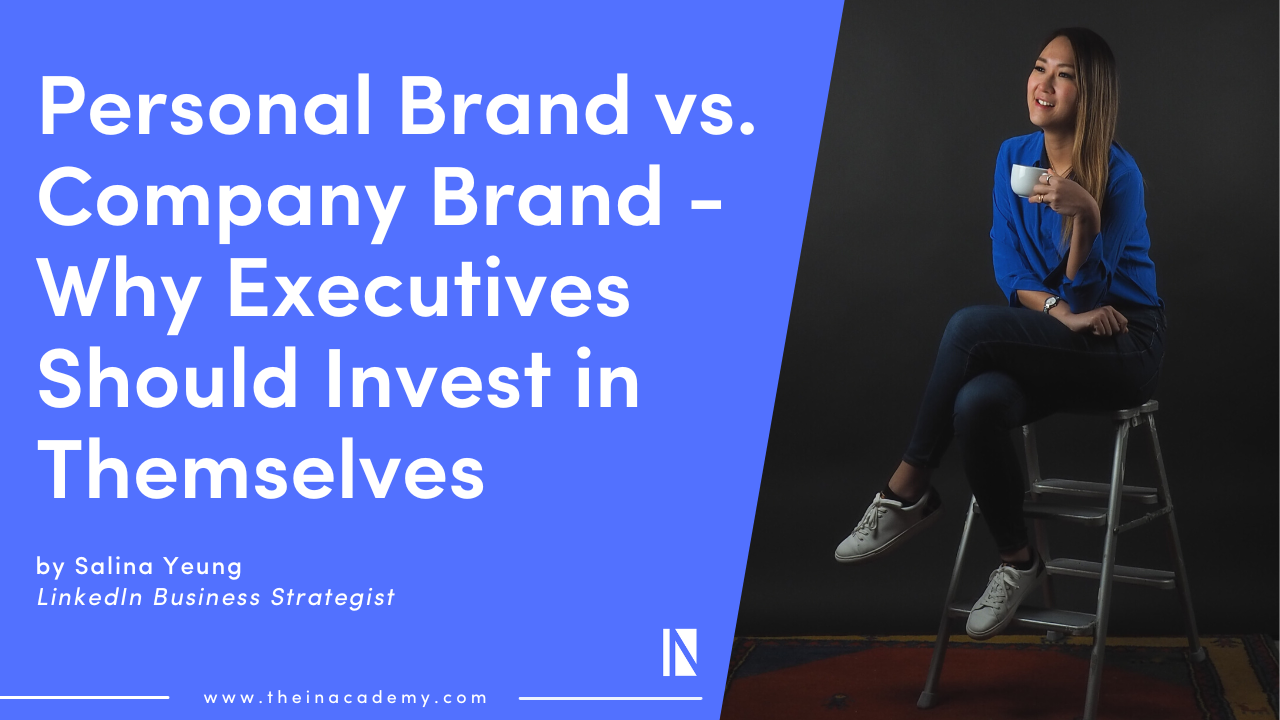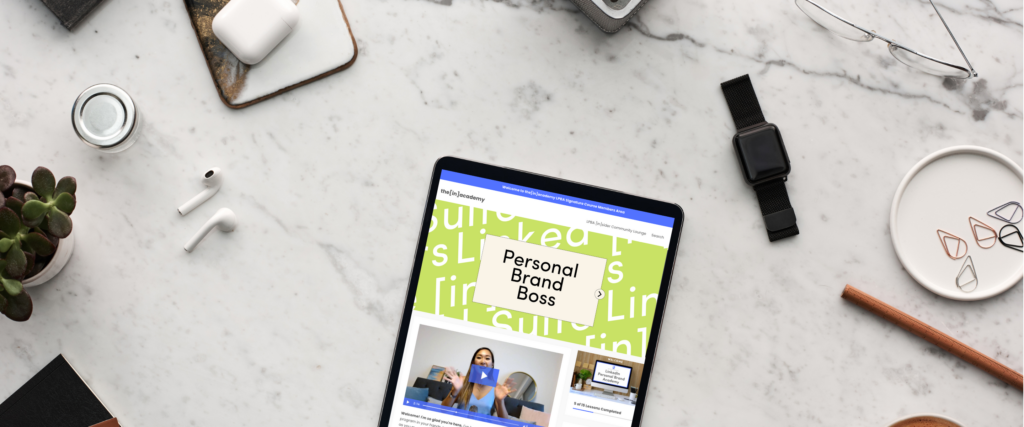Personal Brand vs. Company Brand – Why Executives Should Invest in Themselves

If the company you worked for didn’t exist tomorrow, what would you be known for in the professional community? How would people describe or refer to you without the title of your role?
These aren’t the easiest questions to answer, but worth the time to take a closer look at your personal brand vs. the company brand you work for.
Whether you are a company executive or just starting your career, you may be unknowingly putting more time and effort into the company’s brand than your own.
But not to worry, I share the distinction between the two branding definitions and why it’s not only vital for you to invest in your brand but how it can also be beneficial to your career.
Let’s start with the definitions. What’s the difference between a personal brand vs. a company’s brand?
What’s The Difference Between Personal Brand vs. Company Brand?
A personal brand is a distinct impression of how people know and remember you as an individual professional. A company’s brand is the public’s perception of its reputation from its services, product offering, company culture, and recognizable logo.
A company’s brand is built on transactional interactions with its customers and employees, while a personal brand is developed through intentional relationship-building through storytelling and expressing thought leadership.
Why Should I Build a Personal Brand?
When talking to business leaders and executives, one of the biggest misconceptions about a personal brand vs. a company’s brand is the belief that their brand wouldn’t exist or hold value without the company’s brand. And why they only create a post on LinkedIn about the company rather than focusing on their individual brand.
But in reality, consumers and prospects want to learn more about the people in charge of the company. Posting content about your career background and experiences as a business leader can help humanize the company’s brand. It positions you as a thought leader and allows the company to create a distinction from its competitors.
In a survey conducted by Glassdoor, 75% surveyed believed C-level executives who communicated consistently on social media about their core mission, values, and purpose were considered trustworthy overall.
How Do I Build a Personal Brand as an Executive?
You already know that building a brand doesn’t happen overnight and involves a process of research, taking action, testing, and retaking action. You can start with a personal brand audit, then audit and optimize your LinkedIn profile.
LinkedIn is the key platform you should spend your time and focus on building your personal brand.
As an exec, you’ve got so much on your plate but you know the importance of having an optimized and highly engaging LinkedIn profile is vital to building your professional brand online.
Do what you do well, and delegate the LinkedIn profile optimization to me. Book a 1:1 call to learn how I can turn your ordinary profile into an extraordinary read.
Personal Brand Audit
A personal brand audit gathers information from old colleagues, trusted peers, and previous employees to learn how they would describe you professionally.
These informal and informational conversations will help you better understand the keywords people use to describe you as a professional.
Be open and get curious about people’s perceptions of your brand. Whatever words they used to describe you professionally will be your guide to create more intentional action or cause you to pivot your brand on characteristics that you want to be known for more accurately.
Audit LinkedIn Profile
After collecting the information from your conversations, the next step is to evaluate your LinkedIn profile.
A profile should take the reader through a descriptive story of who you are as a professional (OK, add some personal background information too), your core values, mission, and purpose. It should not be another variation of your resume.
Your LinkedIn profile is an opportunity to tell your personal brand story using the keywords gathered from your audit.
Optimize Your LinkedIn Profile
If you discover your LinkedIn profile is missing an element of storytelling, there is no need to panic or stress. There are specific sections of your LinkedIn profile when used correctly, and are perfect touch points for your personal brand.
- Headline
- About section
- Feature section
The headline (text right beneath your profile picture) is the first impression of your professional brand. It should include what you do, who you help, how you help them, and a unique value proposition.
Your “About” section should not be an essay for your work experience. Instead, it should be a nice balance of sharing who you are, your purpose or why you help others, and how you’ve helped others. After reading this section, a reader should have a better sense of your personality and purpose.
And lastly, the “Feature” section is an opportunity to hand-pick posts to highlight your thought-leadership, an accomplishment, or brand message. Highlighting 3-4 LinkedIn posts enables you to paint a picture of your personal brand for a new connection.
Not sure if your LinkedIn profile is optimized for visibility and reach on the platform? Don’t you wish you had a list of all the key parts to optimize your profile? Wish granted! Grab my LinkedIn Profile Checklist to set your profile up the right way.
A Personal Brand Needs Content
You can’t build a personal brand online without publishing content consistently so people will get to learn, like, and trust you.
But only having a LinkedIn profile alone is not enough. Creating content paints a picture of who you are professionally and what it’s like to work with you. Every time you publish a piece of content is like adding color to your LinkedIn profile, attracting more people to it.
I suggest my clients start with one piece of content for a few weeks, then work their way up to two pieces of content once they start noticing more views on their LinkedIn profiles. The more content you create the more eyeballs you will attract to your profile.
And one of the faster ways for your content to deliver at scale is with video in a post or streaming live from your LinkedIn Page. Video content has been on the rise for content consumption, especially on LinkedIn, with a 50% uptick in video views and a 437% increase for LinkedIn Live shows.
But if videos aren’t your cup of coffee (I’m a coffee lover), then several other forms of content work well on LinkedIn, such as written posts, articles, or carousel slides. Discover which form ofcontent creation you feel the most comfortable doing to help build the habit of consistency.
Final Takeaway- Personal Brand vs. Company Brand
So if you’re a company executive or first year at a corporate job, developing your personal brands doesn’t stop at the office doors.
View your time spent developing your personal as an investment to future-proof your career that isn’t defined as only working for other companies but is the definition of who you are as a professional holistically.
If you feel overwhelmed with keeping up with what you “should” and “shouldn’t” be doing on LinkedIn, no worries or guilt here. I’ve got you. Learning and understanding all the in’s & outs of LinkedIn is my jam.
📍 Join me [in]side Personal Brand Boss™ – create a follow-worthy personal brand that attracts your ideal clients + Transform your (yawn!) LinkedIn Profile into a highly converting sales page and so much more…

theinacademy.com
Take a look around.
[in]side the algorithm
Inside the Algorithm is your weekly download of all things business and magnetic content marketing, from exclusive LinkedIn insider Tips by Salina & Faisal to incredible guest contributors.
JUICY DEETS EVERY WEDNESDAY MORNING!


